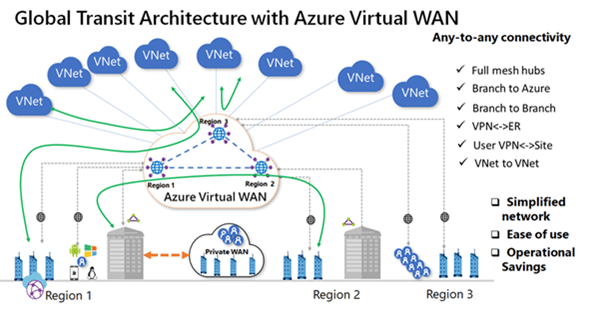

Organisations across the globe are adjusting to the new reality of remote work to ensure the safety and well-being of their employees. IT departments are playing a crucial role in enabling remote collaboration however many are facing infrastructure challenges when helping remote users connect to on-premises resources.
Today’s dynamic environment demands rapid enablement of remote connectivity. Azure Virtual WAN supports multiple scenarios providing large scale connectivity and security in just a few clicks. Independent Software Vendors can quickly use Virtual WAN to deploy remote user connectivity in minutes and provide access to on-premises resources.
Azure Virtual WAN is a networking service that brings many networking, security, and routing functionalities together to provide a single operational interface. These functionalities include branch connectivity, site-to-site VPN connectivity, remote user VPN connectivity, private connectivity, intra-cloud connectivity, VPN ExpressRoute inter-connectivity, routing, Azure Firewall, and encryption for private connectivity. You do not have to have all of these use cases to start using Virtual WAN. You can simply get started with just one, and then adjust your network as it evolves.
Integrated connectivity solutions in hub and spoke:
Automate site-to-site configuration and connectivity between on-premises sites and an Azure hub.
Automated spoke setup and configuration:
Connect your virtual networks and workloads to the Azure hub seamlessly.
Intuitive troubleshooting:
You can see the end-to-end flow within Azure, and then use this information to take required actions

Set up remote user connectivity:
Connect to your Azure resources with an IPsec/IKE (IKEv2) or OpenVPN connection. This requires a virtual private network (VPN) client to be configured for the remote user. The Azure VPN Client, OpenVPN Client, or any client that supports IKEv2 can be used.
Enable connectivity from the remote user to on-premises:
Set up Site-to-Site connectivity with an existing VPN device. When you connect the IPsec VPN device to Azure Virtual WAN hub, interconnectivity between the Point-to-Site User VPN (remote user) and Site-to-Site VPN is automatic.
Connect your ExpressRoute circuit to the Virtual WAN hub. Connecting an ExpressRoute circuit requires deploying an ExpressRoute gateway in Virtual WAN. As soon as you have deployed one, interconnectivity between the Point-to-Site User VPN and ExpressRoute user is automatic. You can use an existing ExpressRoute circuit to connect to Azure Virtual WAN.
Connect your Azure resources to the Virtual Hub:
Select a Virtual Network and attach it to your hub of choice.
Set up firewall policies in Virtual Hub:
A secured virtual hub is an Azure Virtual WAN hub with associated security and routing policies configured by Azure Firewall Manager. Use secured virtual hubs to easily create native security services for traffic governance and protection. You can choose the services to protect and govern your network traffic with Azure Firewall. Azure Firewall Manager also allows you to use your familiar, best-in-breed, third-party security as a service offering to protect Internet access for your users.
To learn more about these technologies and migrating to the Azure environment
contact our team.